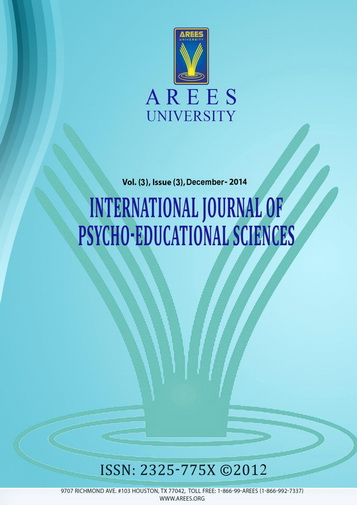The Impact of Implementing Enhanced Milieu Teaching Strategies on the Communication Skills of Young Children with Autism Spectrum Disorder
Keywords:
Touch Math program, children with autism, academic achievement, math additionAbstract
The purpose of this study was to explore effect of implementing Enhanced Milieu Teaching Strategies on the Communication Skills of Young hildren with Autism Spectrum Disorder. Children participants diagnosed using Autism Spectrum Disorder Evaluation Inventory (Mohammed, 2006), were invited to participate. The sample was randomly divided into two groups; experimental (n=5) and control (n=5). Findings from this study indicated the effectiveness of the program employed in math skills in the target children. On the basis of the findings, the study supports the idea of Touch Math as a powerful intervention for children.Downloads
References
Adel Abdulla, M.& Mourad , A. Eissa (2014). Contemporary Perspectives on autism Identification, assessment, problems, intervention, and instruction. Arees University Press.
Alpert, C. L., & Kaiser, A. P. (1992). Training parents as milieu language teachers. Journal of Early Intervention, 16(1), 31-52.
American Psychiatric Association. (2000). Diagnostic and statistical manual for mental disorders (4th ed., Rev. ed.). Washington, D.C.: American Psychiatric Association.
Durand, V. M., & Merges, E. (2001). Functional communication training: A contemporary behavior analytic intervention for problem behaviors. Focus on Autism and the Developmental Disabilities, 16, 110-119.
Hancock, T. B., & Kaiser, A. P. (2002). The effects of trainer-implemented enhanced milieu teaching on the social communication of children with autism. Topics in Early Childhood Special Education, 22(1), 39-54.
Hart, B. M., & Risley, T. R. (1968). Establishing use of descriptive adjectives in the spontaneous speech of disadvantaged preschool children. Journal of Applied Behavior Analysis, 1(2), 109-120.
Heflin, L. J., & Alaimo, D. F. (2006). Students with autism spectrum disorders: Effective instructional practices. Upper Saddle River, NJ: errill/Prentice Hall.
Hester, P. P., Kaiser, A. P., Alpert, C. L., & Whiteman, B. (1995). The generalized effects of training trainers to teach parents to implement milieu teaching. Journal of Early Intervention, 20(1), 30-51.
Kaiser, A. P. (1993). Parent-implemented language intervention: An environmental system perspective. In A. P. Kaiser & D. B. Gray (Eds.), Enhancing children’s communication: Research foundations for intervention (pp. 63-84). Baltimore: Paul H. Brookes Publishing Co.
MacDuff, G. S., Krantz, P. J., MacDuff, M. A., & McClannahan, L. E. (1988). Providing incidental teaching for autistic children: A rapid training procedure for therapists. ducation and Treatment of Children, 11(3), 205-217.
Ross, D. E., & Greer, R. D. (2003). Generalized imitation and the mand: Inducing first instances of speech in young children with autism. Research in Developmental Disabilities, 24, 58-74.
Schreibman, L. (2005). The Science and Fiction of Autism. Cambridge: Harvard University Press.
Sigafoos, J. (2000). Communication development and aberrant behavior in children with developmental disabilities. Education and Training in Mental Retardation and Developmental Disabilities, 35, 168-176.
Spradlin, J. E., & Siegel, G. M. (1982). Language training in natural and clinical environments. Journal of Speech and Hearing Disorders, 47, 2-6.
Tsatsanis, K.D. (2005). Neuropsychological characteristics in autism and related conditions. In F.R. Volkmar, R. Paul, A. Klin, & D. Cohen (Eds.),Handbook of Autism and Pervasive Developmental Disorders, Vol 1. (pp 365-381). Hoboken, NJ: John Wiley & Sons, Inc.
Volkmar, F.R., & Klin, A. (2005). Issues in the classification of autism and related conditions. In F.R. Volkmar, R. Paul, A. Klin, & D. Cohen (Eds.), Handbook of Autism and Pervasive Developmental Disorders, Vol 1. (pp 5-41). Hoboken, NJ: John Wiley & Sons, Inc.
Warren, S. F., & Gazdag, G. (1990). Facilitating early language development with milieu intervention procedures. Journal of Early Intervention, 14(1), 62-86.
Yoder, P. J., & Warren, S. F. (2002). Effects of prelinguistic milieu teaching and parent responsivity education on dyads involving children with intellectual disabilities. Journal of Speech, Language, and Hearing Research, 45, 1158-1174.
Yoder, P. J., et al. (1995). An exploratory comparison of milieu teaching and responsive interaction in classroom applications. Journal of Early Intervention, 19(3), 218-242.
Additional Files
Published
How to Cite
Issue
Section
License

This work is licensed under a Creative Commons Attribution-NonCommercial-NoDerivatives 4.0 International License.










